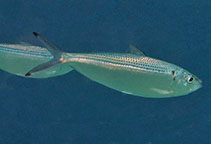| Family: |
Dorosomatidae (Gizzard shads and sardinellas) |
| Max. size: |
38 cm TL (male/unsexed); max.weight: 375.0 g |
| Environment: |
reef-associated; marine; depth range 1 - 50 m |
| Distribution: |
Western Atlantic: Gulf of Maine (USA), Bermuda, throughout the Gulf of Mexico, Caribbean and West Indies southward to Santa Catarina, Brazil. Also found in Uruguay (Ref. 54736) and Argentina (Ref. 2806). |
| Diagnosis: |
Dorsal spines (total): 0-0; Dorsal soft rays (total): 19-21; Anal spines: 0-0; Anal soft rays: 23-24. The filamentous last dorsal fin ray distinguishes this species from all other western Atlantic clupeoids except Dorosoma, which has an inferior mouth (Ref. 188). Otherwise, superficially resembles species of Sardinella (but i 8 pelvic fin rays in western Atlantic species, cf. i 7 in Opisthonema) and Harengula (but small toothed hypomaxilla in upper jaw) (Ref. 188). Lower gill rakers stable at 28 to 46 after 8 cm (Ref. 188). Silvery, with a bluish or greenish back, 6-7 lengthwise dark streaks on side. Dark spot above opercle, larger dark spot behind opercle, usually with a row of dark spots behind it. Lower profile deeply curved. Head pointed (Ref. 7251). |
| Biology: |
Inhabit harbors and shallow coastal areas (Ref. 9710). Pelagic (Ref. 27549). Form schools (but solitary individuals reported), probably not entering water of low salinity. Feed by filtering plankton (copepods), but also take small fishes, crabs and shrimps. Marketed fresh, frozen and salted; also used in the fishmeal industry. Occur in freshwater in St. Johns River, Florida (Ref. 26938). |
| IUCN Red List Status: |
Least Concern (LC); Date assessed: 23 August 2012 Ref. (130435)
|
| Threat to humans: |
reports of ciguatera poisoning |
Source and more info: www.fishbase.org. For personal, classroom, and other internal use only. Not for publication.

